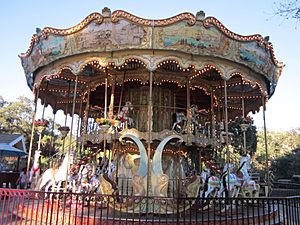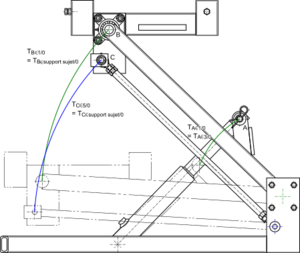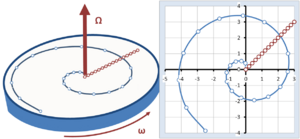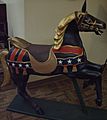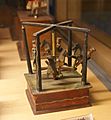Carousel facts for kids
A carousel, also known as a merry-go-round, is a fun ride you can find at an amusement park or on a playground. It has a round platform that spins. Carousels at amusement parks often have seats shaped like cars, trains, or animals. You might see horses, elephants, and swans on them.
Amusement park carousels are usually very colorful. They have bright lights, beautiful paintings, and many different animals. These carousels move using machine power.
Playground carousels are a bit different. Children make them spin by holding onto handle bars and running in a circle. The faster the children run, the faster the merry-go-round spins!
Contents
Other Names for Carousels
People around the world have many different names for carousels. The names "Merry-go-round" and "roundabout" both come from the United Kingdom.
The word "carousel" itself comes from the 17th century. It is a French word that means "a tilting match." This refers to a game played by knights. Today, "merry-go-round" and "carousel" are used to mean the same thing in North America and the United Kingdom.
Since carousels were popular in different places, each region had its own terms.
- In England, a carousel might be called a galloper or a tilt.
- In France, it could be called a riding ring of wooden horses.
- In America, some older names included flying horses, whirlgig, or hobby horses.
Many of these older names were used to attract customers to the rides.
History of Carousels
The very first carousels were probably made in Arabia. They were first used by adults. Today, carousels are mostly for children.
Carousels became well-known in Europe in the 17th century. In France, they were used for a game. Horsemen would practice riding wooden horses on a spinning platform. Servants or even real horses would make the platform spin. This was similar to how playground carousels work today.
In the early 18th century, a toy seller in France showed wooden horses on a spinning platform. This platform was moved by people or horsepower. Carousels became very popular in America between 1880 and 1930. About 5,000 carousels were built during this time!
Michael Dentzel, who came to America from Germany, used steam power to move his carousel in 1814. Later, in 1898, a new concept was invented in America. This allowed amusement park carousels to be moved by a machine. This is still how they work today. Railroad companies were some of the first to buy carousels for their customers to enjoy.
About Carousel Animals
The most popular animal on a carousel has always been the horse. About 80% of carousel animals carved in America are horses. Other animals you might see include "Mother Goose" or "Disney" characters.
The side of the animal that faces the audience is called the "romance" side. This side often has extra carvings and decorations. Most carousels in Europe and America spin counterclockwise. But in Great Britain, carousels usually spin clockwise!
How Carousels Work (Science!)
A carousel platform is usually a little above the ground. A motor in the middle makes the platform spin. Many carousel animals can also move up and down.
The number of seats varies, but carousels usually have between 16 and 60 animals. Each animal is connected to a pole that goes from the floor to the ceiling of the ride.
A carousel usually spins about 5 times a minute. An average ride lasts for 2 to 3 minutes. The ride moves slowly to keep the centrifugal force low. If it spun too fast, the force would be much stronger.
The central axis of the carousel has centripetal force. This force pulls towards the center. It is the opposite of centrifugal force, which pushes outwards.
Gallery
-
A metal playground carousel of Soviet design
-
A children's mechanical toy carousel
-
A simple powered carousel showing much of the mechanism that turns and lifts the seats
Images for kids
-
French old-fashioned carousel with stairs in La Rochelle
-
Carousel feast at the Grand Place in Brussels in 1565 to mark the wedding of the Duke of Parma
-
The "Carousel" organised in the courtyard of the Tuileries Palace by Louis XIV in June, 1662 to celebrate the birth of his son and heir, the future Louis XV
-
Carousel built in 1905 by Gustav Dentzel which is still operational in Rochester, New York.
-
Name Pinta is visible on bow of right hand boat. Location is Munro Park, Toronto which was third site where this attraction was installed.
-
One of the carousels in Endicott, NY, West Endicott Park Carousel
See also
 In Spanish: Carrusel para niños
In Spanish: Carrusel para niños


